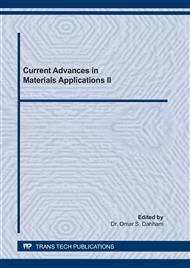[1]
K.H Khayat A. Yahia, and P. Duffy, High-performance cement grout for post-tensioning applications. Materials Journal 96(1999)471-477.
Google Scholar
[2]
Shannag, M.J., High-performance cementitious grouts for structural repair. Cement and concrete research 32 (2002) 803-808.
DOI: 10.1016/s0008-8846(02)00710-x
Google Scholar
[3]
A.A. Al-Manaseer, and L.D Keill, Physical properties of cement grout containing silica fume and superplasticizer. Materials Journal 89(1992)154-160.
DOI: 10.14359/2227
Google Scholar
[4]
J. Bastien, Dugat, J. and Prat, E., Cement grout containing precipitated silica and superplasticizers for post-tensioning. Materials Journal, 94(1997)291-295.
DOI: 10.14359/311
Google Scholar
[5]
Duxson, Peter, L. John Provis, C. Grant Lukey, and SJ Jannie Van Deventer, The role of inorganic polymer technology in the development of green concrete'., cement and concrete research 37 (2007)1590-1597.
DOI: 10.1016/j.cemconres.2007.08.018
Google Scholar
[6]
E. Vasconcelos, S. Fernandes, JB De Aguiar, F. Pacheco-Torgal, Concrete retrofitting using metakaolin geopolymer mortars and CFRP. Construction and Building Materials 8 (2011)3213-21.
DOI: 10.1016/j.conbuildmat.2011.03.006
Google Scholar
[7]
Information on www.fosroc.com.
Google Scholar
[8]
A. M. Shende, A. M. Pande, and M. Gulfam Pathan, Experimental study on steel fiber reinforced concrete for M-40 grade. International Refereed Journal of Engineering and Science 1 (2012) 043-048.
Google Scholar
[9]
Abbass, Wasim, M. Iqbal Khan, and Shehab Mourad, Evaluation of mechanical properties of steel fiber reinforced concrete with different strengths of concrete. Construction and building materials 168 (2018)556-569.
DOI: 10.1016/j.conbuildmat.2018.02.164
Google Scholar
[10]
ASTM C33. Standard Specification for Concrete Aggregate. Annual Book of ASTM Standard. (2003).
Google Scholar
[11]
J Wongpa, Kiattikomol K, Jaturapitakkul C, Chindaprasirt P. Compressive strength, modulus of elasticity, and water permeability of inorganic polymer concrete. Materials & Design 31 (2010)4748-54.
DOI: 10.1016/j.matdes.2010.05.012
Google Scholar
[12]
Gupta, S., D.S. Sharma, and D.D. Sharma, A review on alccofine, a supplementary cementitious material. International Journal of Modern Trends in Engineering and Research 3(2013)148-153.
Google Scholar
[13]
F. Wafa, Properties and Applications of Fiber Reinforced Concrete, JKAU: Eng. science Journal 2(1990) -49-63.
Google Scholar
[14]
M. Musmar, Tensile strength of Steel Fiber Reinforced Concrete, Contemporary Engineering Sciences 6,(2013)225-237.
DOI: 10.12988/ces.2013.3531
Google Scholar


